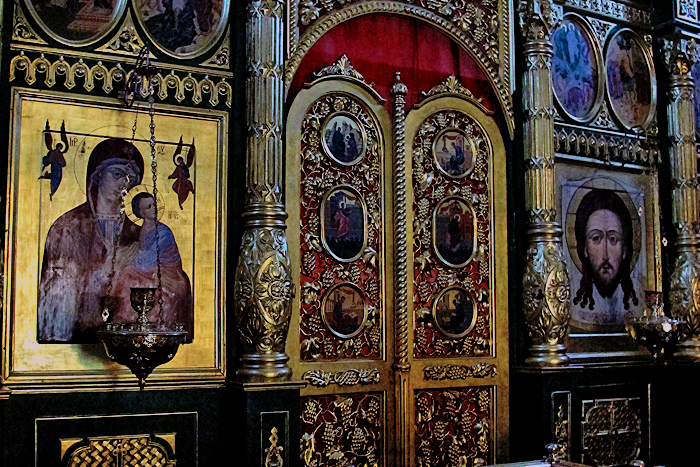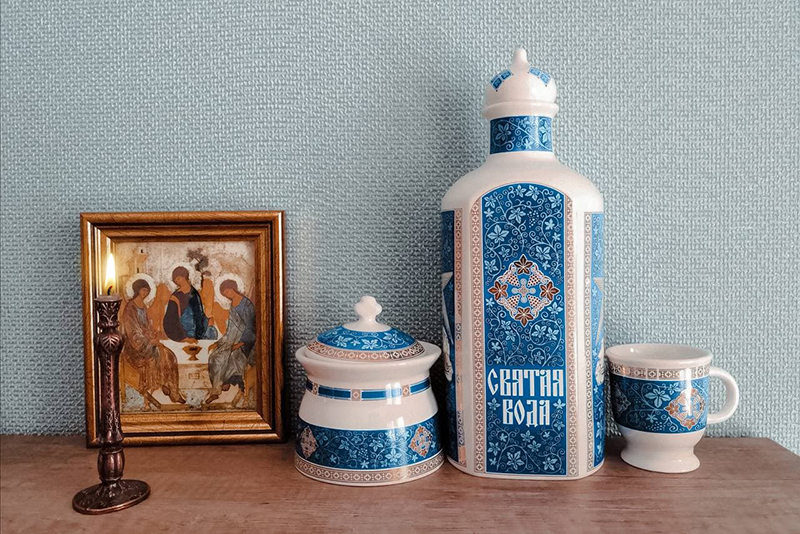
Everyone who comes to the church early enough to attend the Divine Liturgy may see the clergy doing the so-called entrance prayers. What are they, when did they appear, and what is their purpose?
Purpose
Entrance prayers are a special short prayer sequence performed by clergy in front of the Royal Door of the iconostasis before the Divine Liturgy. This rite is not performed before the services of the daily circle (with the exception of the Hellenistic Churches, where the rite precedes the Matins, which is then seamlessly connected to the Divine Liturgy), because it is effectively the first part of the proskomedia, i. e. the preparation of bread and wine for the Sacrament of the Body and Blood of the Savior at the Eucharist. The clergymen read penitential troparia and, while saying special troparia, kiss the icons of Jesus Christ and the Mother of God, ask forgiveness from each other and the people, and then enter the altar in order to dress up in sacred vestments and begin to prepare the Gifts.
Little Entrance
There is no record of the entrance prayers in the oldest surviving manuscripts of the Hieratikon, of course, because this rite is quite recent. In the earliest times, the entrance prayer was the same prayer (O Master, Lord our God, Who hast appointed in Heaven legions and Hosts of Angels and Archangels for the service of Thy Glory, grant that with our entrance there may be an entrance of Holy Angels serving with us and glorifying Thy goodness; for to Thee are due all glory, honor, and worship; to the Father, and to the Son, and to the Holy Spirit; now and for ever and from all Ages to all Ages. Amen), which the priest reads before coming out at the Little Entrance, because the Little Entrance used to be the first rite of the Liturgy. According to Saint John Chrysostom, lay people were waiting for the priest to come in before the Liturgy, and when he entered the meeting and blessed the congregation, everyone sat down and listened to the Scriptures. Gradually the beginning of the Liturgy was augmented by such elements as the singing of three antiphons, which used to be sung by the believers on their way to the temple. When they started to sing them in the church, the rite of the Little Entrance lost its original meaning as the entrance into the church, and its place was taken by the entrance prayers. This idea is confirmed by the fact that in some Greek manuscripts that contain the rite of St. John Chrysostom, instead of the usual prayer of the Little Entrance (O Master, Lord our God…) there is also an alternative version of the entrance prayers (Jacob. Formulaire. P. 85-93, 202-203). A similar situation can be seen from the text of the Hieratikon of St. Anthony the Roman, where one of the entrance prayers is listed in the order of the Great Entrance.
Adoption of Entrance Prayers in Russia
In the practice of the Russian Church, beginning in the 15th-16th centuries, entrance prayers began to gradually acquire new elements. This included Psalms 15 (Lord, who shall abide in thy tabernacle?) and 23 (The LORD is my shepherd); then there appeared brief prayers on the way to the temple and at the entrance to the temple. The rite itself was very diverse and over time it split into two separate sequences – the rite of the entrance to the church and the rite of the entrance to the sanctuary. The variability of these rites led to the desire to unify the order of the entrance prayers, which was done at the Stoglavy Sobor of the Russian Orthodox Church in 1551. The fusion of two rites in one led to an even more complicated, truly “Byzantine” pattern of entrance prayers, which, after reading the prayers and psalms on the way to the church and in front of the church, even had their own dismissal. It is precisely because of this old Russian pre-reform code of entry into the House of God that there is a tradition of singing It Is Truly Meet when priests meet the bishop at the church gates. Singing this particular chant, which usually comes at the end of every service, during the meeting of a bishop can be perplexing, but originally this prayer was part of the dismissal of the first set of entrance prayers when the bishop entered the church.
Pre-Reform Practice
The structure of the entrance prayers that developed in Russia after the Stoglavy Sobor, in the 16th-17th centuries, is fascinating. Their first part, which took place before the entrance to the church, consisted of two prayers and two aforementioned Psalms – Psalm 15 and Psalm 23. Then they sang It Is Truly Meet, and read the dismissal. By the beginning of the second part, the priest put on his epitrachelion and, standing with the deacon in front of the iconostasis, blessed the beginning of the second part. Four penitential troparia were read. Then the clergy bowed to both sides of the Holy Door, while also reading the corresponding troparia. Next came the troparia “To Thy pure image…” and “All Creation Rejoiceth in Thee”. After reading the troparion of the day or the feast, the troparion to the patron saint of the church and the author of the Liturgy, there was kissing of each icon in the church, starting with the Holy Door, to the icons of the iconostasis and all the images in general in the church, and they would also bow before each icon and read the corresponding troparion (Sluzhebnik 1646, Moscow. P. 69.- 77). As we can see, the pious practice of entrance prayers in this era turned a simple prayer of entering the church into a whole separate service, which could take quite a long time.
Reading the Prayers Wearing an Epitrachelion?
In conclusion, it should be noted that after the Nikonian reforms, the office of entrance prayers was significantly abridged, brought into compliance with Greek tradition, and remains unchanged to this day. The only controversial issue is the need to put on an epitrachelion when reading the entrance prayers. The practice of going to the altar to put on the epitrachelion and then going back and saying the entrance prayers appears a little illogical and inconsistent. An older and more coherent practice is to read these prayers without the epitrachelion as it is put on after entering the altar, which is both sensible and grounded in history. One solution may be hanging the epitrachelion on a pillar of the Royal Door, as seen in some monasteries and parishes. However, depending on the arrangement of the church, specific features of the building and other factors, it is not always possible to combine the Typicon logic with convenient flow of the service.



